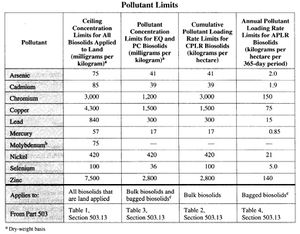Class A Biosolids
|
WARNING! Sewage sludge is toxic. Food should not be grown in "biosolids." Join the Food Rights Network. |
Class A Biosolids is a designation for dewatered and heated sewage sludge that meets U.S. EPA guidelines for land application with no restrictions. Thus, class A biosolids can be legally used as fertilizer on farms, vegetable gardens, and can be sold to home gardeners as compost or fertilizer. Compared to Class B Biosolids, Class A Biosolids are virtually the same, but with stricter limits on pathogens and "vector attraction" (i.e. class A biosolids must not attract disease-carrying insects or rodents, etc). The EPA claims that Class A biosolids must "contain no detectible levels of pathogens"[1] but the only pathogens actually measured and regulated in the law are fecal coliform and salmonella.[2] Despite the U.S. EPA's assurances of safety,[3], the safety requirements for Class A Biosolids do nothing to regulate or limit the numerous other contaminants routinely found in sewage sludge.
Contents
U.S. EPA Standards for Metal Contaminants in Class A Biosolids
The U.S. EPA sets limits for concentrations of ten metals in sewage sludge classified as Class A Biosolids.[4] All concentrations listed are dry-weight concentrations:
- Arsenic: 75 parts per million (ppm)
- Cadmium: 85 ppm
- Chromium: 3000 ppm
- Copper: 4,300 ppm
- Lead: 840 ppm
- Mercury: 57 ppm
- Molybdenum: 75 ppm
- Nickel: 420 ppm
- Selenium: 100 ppm
- Zinc: 7,500 ppm
Vector Attraction Reduction Standards
According to the book Advanced Biological Treatment Processes:[5]
- "The term Exceptional Quality is often used to describe a biosolids product which meets Class A pathogen reduction requirements, the most stringent metals limits (Pollutant Concentrations), and vector attraction reduction standards specified in the Part 503 Rule. Vectors (flies, mosquitoes, rodents, birds, etc.) can transmit diseases directly to humans or play a specific role in the life cycle of a pathogen as a host. Vector attraction reduction refers to processing which makes the biosolids less attractive to vectors thereby reducing the potential for transmitting diseases."
Consideration of Additional Regulation
2003: EPA Declined to Regulate Dioxins in Sewage Sludge
In 2003, the EPA announced that it would not regulate dioxins in sewage sludge applied to land as fertilizer, even when used on farms and gardens where food is grown. The Natural Resources Defense Council (NRDC) criticized this decision, saying it violates the Clean Water Act.
- "Dioxins cause cancer and diabetes, as well as nervous system and hormonal problems," said Nancy Stoner, director of NRDC's Clean Water Project. "And the EPA is required by law to protect the public from toxic pollutants like dioxins. This decision shows the agency under this administration has forgotten its mission."[6]
Stoner added:
- "EPA traditionally limits public exposure to chemicals if they pose a cancer risk of one per 1 million Americans," Stoner explained. "But the risk is 1 in 10,000 from the dioxins we already have in our bodies. And cancer isn't the only problem. The EPA itself has said that the non-cancer risks of dioxins are so high that it can't even calculate a 'safe' or acceptable level of exposure. To us that says EPA should keep dioxins out of our food, and that means, among other things, regulating sewage sludge."[7]
NRDC called on the EPA to do the following:
- "Prohibit sludge application on land used for pasture or growing forage food for livestock that will be consumed by humans;
- "Set a dioxins limit at 1 in one million cancer risk to protect public health;
- "Ban land application to sites where dioxin levels in the soil [exceed] 1 parts per trillion (based on ecological risks that cannot be alleviated by management measures, such as banning application to pasture lands, which would reduce risks to human health); and
- "Require pollution prevention programs for sludges with detectible amounts of dioxins."[8]
2004: EPA Considered Regulating More Pollutants
In 2004, the EPA announced it might regulate 15 more pollutants found in sewage sludge: acetone, anthracene, barium, beryllium, carbon disulfide, 4-chloroaniline, diazinon, fluoranthene, manganese, methyl ethyl ketone, nitrate, nitrite, phenol, pyrene and silver. "The 15 chemicals already are considered hazardous enough to be a potential threat to the health of people and wildlife species, EPA said."[9]
Articles and Resources
Related SourceWatch articles
References
- ↑ Frequently Asked Questions: Sewage Sludge (Biosolids), U.S. EPA, Accessed April 24, 2011.
- ↑ EPA's Guide to Part 503 Rule, Chapter 2, Land Application of Biosolids, p. 37.
- ↑ http://www.epa.gov/owmitnet/mtb/biosolids/genqa.htm
- ↑ Code of Federal Regulations, Title 40, Chapter 1, Subchapter O, PART 503—Standards for the Use or Disposal of Sewage Sludge, Subpart B—Land Application, Pollutant Limits
- ↑ Lawrence K. Wang, Norman C. Pereira, Yung-Tse Hung, Advanced Biological Treatment Processes, Humana Press, 2009, p. 482
- ↑ EPA Will Not Protect Public From Dioxins In Land-Applied Sewage Sludge, Natural Resources Defense Council, October 17, 2003, Accessed May 12, 2011.
- ↑ EPA Will Not Protect Public From Dioxins In Land-Applied Sewage Sludge, Natural Resources Defense Council, October 17, 2003, Accessed May 12, 2011.
- ↑ EPA Will Not Protect Public From Dioxins In Land-Applied Sewage Sludge, Natural Resources Defense Council, October 17, 2003, Accessed May 12, 2011.
- ↑ John Heilprina, "15 Sewage Chemicals Could Face Regulation; Fertilizer Plea Ignored," Saint Paul Pioneer Press, January 1, 2004.
External resources
External articles
| This article is a stub. You can help by expanding it. |

